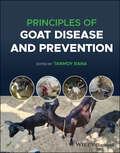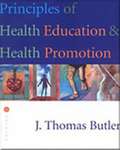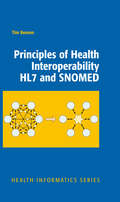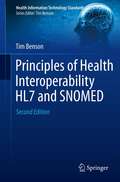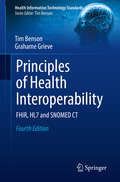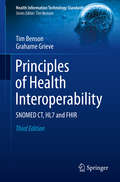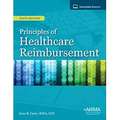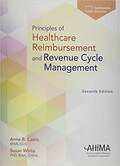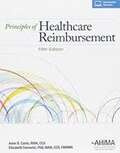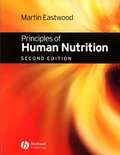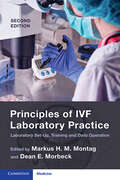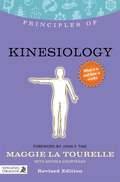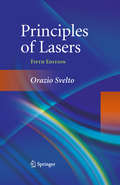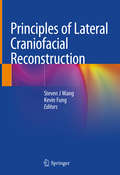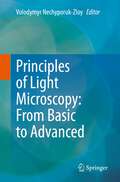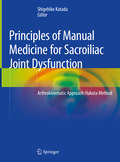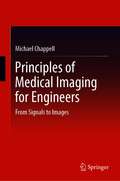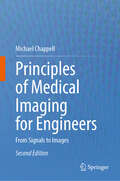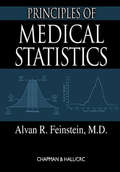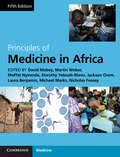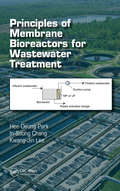- Table View
- List View
Principles of Goat Disease and Prevention
by Tanmoy RanaPRINCIPLES OF GOAT DISEASE AND PREVENTION Learn to diagnose, treat, and clinically manage a wide variety of diseases in goats?? In Principles of Goat Disease and Prevention, veterinary medicine expert Dr. Tanmoy Rana delivers a singularly informative resource covering infectious diseases affecting ruminant animals. The book offers key insights into the most important aspects of common and unusual diseases affecting goats, providing clinical management best practices for veterinary practitioners engaged in the diagnosis and treatment of ruminant diseases.?? The author explains ruminant disease, as well as its diagnosis and treatment, systematically, explaining the etiopathogenesis of various pathogens, clinical symptoms, disease prevention and control, and the most recent advances in identifying and treating diseases in goats. Readers will also find: A thorough introduction to managing nutrition in goats Comprehensive explorations of the handling and restraining of goats for the purpose of veterinary treatment Practical discussions of the collection, preservation, processing, and shipment of clinical materials in the treatment of goats Fulsome treatments of parasitic, bacterial, fungal, viral, and other diseases of goats, as well as the management of pain from surgery and lameness Perfect for undergraduate, postgraduate, and doctoral students studying veterinary medicine, Principles of Goat Disease and Prevention will also benefit practitioners and students with an interest in studying or preventing disease in ruminants.????
Principles of Health Care Ethics
by Angus Dawson John Mcmillan Richard Edmund Ashcroft Heather DraperEdited by four leading members of the new generation of medical and healthcare ethicists working in the UK, respected worldwide for their work in medical ethics, "Principles of Health Care Ethics, Second Edition" is a standard resource for students, professionals, and academics wishing to understand current and future issues in healthcare ethics. With a distinguished international panel of contributors working at the leading edge of academia, this volume presents a comprehensive guide to the field, with state of the art introductions to the wide range of topics in modern healthcare ethics, from consent to human rights, from utilitarianism to feminism, from the doctor-patient relationship to xenotransplantation. This volume is the Second Edition of the highly successful work edited by Professor Raanan Gillon, Emeritus Professor of Medical Ethics at Imperial College London and former editor of the Journal of Medical Ethics, the leading journal in this field. Developments from the First Edition include: The focus on 'Four Principles Method' is relaxed to cover more different methods in health care ethics. More material on new medical technologies is included, the coverage of issues on the doctor/patient relationship is expanded, and material on ethics and public health is brought together into a new section.
Principles of Health Education & Health Promotion (third edition)
by J. Thomas ButlerThe discipline of health education and the practice of health promotion are continually evolving.
Principles of Health Interoperability HL7 and SNOMED
by Tim BensonInteroperability between healthcare computer systems depends on us developing, implementing and deploying appropriate standards, such as HL7 and SNOMED CT, working together as a tightly specified language.<P><P> The documentation of HL7 and SNOMED runs to tens of thousands of pages and creates a steep learning curve and barrier to entry. Principles of Health Interoperability HL7 and SNOMED provides a clear introduction to these standards, explaining the core principles for the health IT professional, student, clinician and healthcare manager.
Principles of Health Interoperability HL7 and SNOMED, 2nd Edition
by Tim BensonThe aims and scope of the second edition are unchanged from the first edition. The major market is in health informatics education. The three part format, which covers principles of health interoperability, HL7 and interchange formats, and SNOMED CT and clinical terminology, works well.<P><P> In the US, The ONC (Office of the National Coordinator for Health Information Technology) has estimated that the HITECH stimulus will create more than 50,000 new jobs for health informatics professionals, who need to be educated.
Principles of Health Interoperability: FHIR, HL7 and SNOMED CT (Health Information Technology Standards)
by Tim Benson Grahame GrieveThis extensively updated fourth edition expands the discussion of FHIR (Fast Health Interoperability Resources), which has rapidly become the most important health interoperability standard globally. FHIR can be implemented at a fraction of the price of existing alternatives and is well suited for use in mobile phone apps, cloud communications and electronic health records. FHIR combines the best features of HL7’s v2, v3 and CDA while leveraging the latest web standards and clinical terminologies, with a tight focus on implementation. Principles of Health Interoperability has been completely re-organised into five sections. The first part covers the core principles of health interoperability, while the second extensively reviews FHIR. The third part includes older HL7 standards that are still widely used, which leads on to a section dedicated to clinical terminology including SNOMED CT and LOINC. The final part of the book covers privacy, models, XML and JSON, standards development organizations and HL7 v3. This vital new edition therefore is essential reading for all involved in the use of these technologies in medical informatics.
Principles of Health Interoperability: SNOMED CT, HL7 and FHIR (Health Information Technology Standards)
by Tim Benson Grahame GrieveThis book provides an introduction to health interoperability and the main standards used. Health interoperability delivers health information where and when it is needed. Everybody stands to gain from safer more soundly based decisions and less duplication, delays, waste and errors. The third edition of Principles of Health Interoperability includes a new part on FHIR (Fast Health Interoperability Resources), the most important new health interoperability standard for a generation. FHIR combines the best features of HL7’s v2, v3 and CDA while leveraging the latest web standards and a tight focus on implementability. FHIR can be implemented at a fraction of the price of existing alternatives and is well suited for use in mobile phone apps, cloud communications and EHRs. The book is organised into four parts. The first part covers the principles of health interoperability, why it matters, why it is hard and why models are an important part of the solution. The second part covers clinical terminology and SNOMED CT. The third part covers the main HL7 standards: v2, v3, CDA and IHE XDS. The new fourth part covers FHIR and has been contributed by Grahame Grieve, the original FHIR chief.
Principles of Healthcare Reimbursement
by Anne CastoPrinciples of Healthcare Reimbursement integrates information about all US healthcare payment systems into one authoritative resource. Boost your understanding of the complex financial systems in today's healthcare environment, including the basics of health insurance, public funding programs, managed care contracting, and how services are paid. Gain clear insight into how reimbursement systems have made an impace on providers and payers, consumers, public policy makers, and the development of classification and information technology systems over the years.
Principles of Healthcare Reimbursement
by Anne CastoPrinciples of Healthcare Reimbursement 7th Edition
Principles of Healthcare Reimbursement and Revenue Cycle Management
by Anne B. CastoHealth information management (HIM) professionals play a crucial role in the delivery of healthcare services in the US. However, to be fully effective in their roles, HIM professionals need an in-depth understanding of healthcare reimbursement systems, reimbursement methodologies, and payment processes throughout the healthcare industry. Principles of Healthcare Reimbursement and Revenue Cycle Management makes complex topics understandable for students and professionals by clarifying the US healthcare reimbursement maze. This text integrates information about US healthcare reimbursement methodologies and processes into one authoritative source. It examines the complex financial systems within today’s healthcare environment and provides an understanding of the basics of health insurance and public funding programs, managed care concepts, and how services are paid. Step-by-step details about how claims are processed, managed, and paid are provided. This gives the reader an appreciation for the complexity of the healthcare reimbursement process and an understanding of the profound effect reimbursement methodologies and policies have had on healthcare professionals and payers, consumers, public-sector policymakers, and the development of classification and information technology systems over the years.
Principles of Healthcare Reimbursement, Fifth Edition
by Elizabeth Forrestal Anne B. CastoThe fifth edition of Principles of Healthcare Reimbursement provides educators, students, and practitioners with up-to-date information on healthcare payment systems and their effects on the US healthcare delivery system and economy in one authoritative source.
Principles of Human Nutrition
by Martin EastwoodThis exciting new book is the updated and revised second edition of an extremely popular and well-received textbook. Written by Martin Eastwood, well respected internationally in nutritional sciences, this important new edition provides students with a thorough book that should be adopted for course use on many courses worldwide. Taking into account constructive comments received by students and teachers who used and enjoyed the first edition, this new edition retains the original freshness of the 1st edition, looking at nutrition as an exciting discipline. Special features within the book to help students include summaries, boxes and questions. Carefully laid out to assist learning, the book is divided broadly into sections, providing in-depth coverage of the following subjects: food in the community metabolism of nutrients by an individual, dictated by genetic makeup, measurement of an individual’s nutritional status essential, non-essential and non-nutrients; their selection, ingestion, digestion, absorption and metabolism nutritional requirements in the normal individual and for specific diseases Principles of Human Nutrition, 2nd Edition is primarily written as a course text for those studying degree courses in nutrition and dietetics and for students on modular courses on nutrition within other degree courses, e.g. food studies, medicine, health sciences, nursing and biological sciences. It is also of great value as a reference for professional nutritionists and dietitians, food scientists and health professionals based in academia, in practice and in commercial positions such as within the food and pharmaceutical industries. Multiple copies of this valuable book should also be on the shelves of all universities, medical schools and research establishments where these subjects are studied and taught. For supplementary material associated with this textbook and its contents, please visit the web pages for this book, on the publishers’ website: http://www.blackwellpublishing.com/eastwood/ Martin Eastwood was formerly consultant gastroenterologist at the Western General Hospital, Edinburgh, U. K. and Reader in Medicine at the University of Edinburgh, U. K.
Principles of IVF Laboratory Practice: Laboratory Set-Up, Training and Daily Operation
by Montag, Markus H. M. Dean E. MorbeckIn-vitro fertilization (IVF) is a procedure practised worldwide, with patients and practitioners expecting higher live birth rates and excellent standards of quality as methodologies become more established. This practical book covers every stage in the life of an IVF laboratory, from designing and planning the laboratory to training the embryologists and ongoing management and troubleshooting, providing step-by-step protocols for today's best practice. Chapters follow the same structure, allowing readers to translate complex and specialized procedures into a standard workflow. Several new chapters are included in this second edition, including descriptions of the protocol for piezo-ICSI, safe and effective cryostorage of embryos, and how to manage emergency situations in the IVF laboratory. Written by an international team of experts, this is an exemplary portfolio of techniques, providing a good foundation of working practice for both new and experienced embryologists.
Principles of Intensive Psychotherapy
by Frieda Fromm-Reichmann M.D."[This book has] a wealth of clinical and technical detail. As a primer on psychotherapeutic technique this book will. . .bring knowledge and stimulation to the most advanced technician"—Karl A. Menninger "One is continuously aware that here is a truly human being at work, human in the sense of exquisite awareness, on a profoundly intuitive level, of the workings of the human totality. . . . Because of this she can bridge the vast divide that separates us from the psychotic . . . thereby gaining access to the process of recalling the patient to his lost domain."—Louise E. DeRosis, M.D., American Journal of Psychoanalysis
Principles of Kinesiology: What it is, how it works, and what it can do for you
by Anthea Courtenay Maggie La Tourelle John F. ThieKinesiology is a system of natural health care that combines muscle testing with the principles of Chinese medicine to assess energy and body function. A touch therapy, it uses a range of gentle yet powerful healing techniques and can be effective in the treatment of many conditions, including allergies, backache, fatigue, emotional difficulties, headaches and skin and bowel problems. This book describes how kinesiology can help with these problems by correcting imbalances found in the different forms of kinesiology assessment. This introductory guide explains how kinesiology works, how to find a practitioner and how it is usefully applied with other therapies, as well as how self-help techniques can be applied. It will be of interest to anyone considering kinesiology treatment, or simply wanting to find out more about this healing system. Students and practitioners of kinesiology and related practices will find it to be a useful reference, and a perfect introduction to recommend to clients.
Principles of Lasers
by Orazio SveltoThis new Fifth Edition of Principles of Lasers incorporates corrections to the previous edition. The text's essential mission remains the same: to provide a wide-ranging yet unified description of laser behavior, physics, technology, and current applications. Dr. Svelto emphasizes the physical rather than the mathematical aspects of lasers, and presents the subject in the simplest terms compatible with a correct physical understanding.
Principles of Lateral Craniofacial Reconstruction
by Steven J Wang Kevin FungThis text comprehensively reviews the major reconstruction challenges that are associated with the extirpation of tumors of the parotid gland and the lateral craniofacial region. It covers major functional and cosmetic consequences related to facial nerve paralysis, facial contour deformity, and soft tissue loss including the skin, ear, temporal bone, mandible, orbit, and cranial base. The text also includes basic concepts, a practical anatomical defect-based approach, and will highlight specific technical challenges that are commonly encountered in the contemporary era of intensive chemoradiation therapy, the aging population, and global health.Principles of Lateral Craniofacial Reconstruction will be a great resource for residents and fellows in training and practitioners in otolaryngology, plastic surgery, facial plastic surgery, oral maxillofacial surgery, ophthalmology, head and neck surgery, and oculoplastic surgery.
Principles of Light Microscopy: From Basic to Advanced
by Volodymyr Nechyporuk-ZloyThis textbook is an excellent guide to microscopy for students and scientists, who use microscopy as one of their primary research and analysis tool in the laboratory. The book covers key microscopy principles and explains the various techniques such as epifluorescence microscopy, confocal/live cell imaging, SIM/light sheet microscopy, and many more. Easy-to-understand protocols provide helpful guidance for practical implementation in various commercially available imaging systems. The reader is introduced to histology and further be guided through advanced image acquisition, classification and analysis. The book is written by experienced imaging specialists from the UK, other EU countries, the US and Asia, and is based on advanced training courses for master students and PhD students. Readers are not expected to be familiar with imaging and microscopy technologies, but are introduced to the subject step by step. This textbook is indented for biomedical and medical students, as well as scientists and postdocs who want to acquire a thorough knowledge of microscopy, or gain a comprehensive overview of modern microscopy techniques used in various research laboratories and imaging facilities.Chapter 4 is available open access under a Creative Commons Attribution 4.0 International License via link.springer.com.
Principles of Manual Medicine for Sacroiliac Joint Dysfunction: Arthrokinematic Approach-Hakata Method
by Shigehiko KatadaThis book introduces physicians and physiotherapists around the world to the principles and techniques of the Arthrokinematic Approach (AKA)-Hakata method, which is currently being used to treat joint dysfunction, in particular sacroiliac joint dysfunction. Although manual medicine is not popular among young orthopaedic surgeons, it offers a number of benefits with regard to treating functional disorders. Further, the AKA-Hakata method is quite different from conventional manual techniques, as it takes into consideration articular neurology aspects, can prevent many patients from developing severe conditions, and can help avoid unnecessary sacroiliac joint surgery.The authors have extensive experience in this field and especially with this unique manual technique. As such, Principles of Manual Medicine for Sacroiliac Joint Dysfunction offers a valuable guide for physicians and physiotherapists alike, helping them achieve optimal outcomes in the treatment of sacroiliac joint dysfunction.
Principles of Medical Imaging for Engineers: From Signals to Images
by Michael ChappellThis introduction to medical imaging introduces all of the major medical imaging techniques in wide use in both medical practice and medical research, including Computed Tomography, Ultrasound, Positron Emission Tomography, Single Photon Emission Tomography and Magnetic Resonance Imaging. Principles of Medical Imaging for Engineers introduces fundamental concepts related to why we image and what we are seeking to achieve to get good images, such as the meaning of ‘contrast’ in the context of medical imaging. This introductory text separates the principles by which ‘signals’ are generated and the subsequent ‘reconstruction’ processes, to help illustrate that these are separate concepts and also highlight areas in which apparently different medical imaging methods share common theoretical principles. Exercises are provided in every chapter, so the student reader can test their knowledge and check against worked solutions and examples.The text considers firstly the underlying physical principles by which information about tissues within the body can be extracted in the form of signals, considering the major principles used: transmission, reflection, emission and resonance. Then, it goes on to explain how these signals can be converted into images, i.e., full 3D volumes, where appropriate showing how common methods of ‘reconstruction’ are shared by some imaging methods despite relying on different physics to generate the ‘signals’. Finally, it examines how medical imaging can be used to generate more than just pictures, but genuine quantitative measurements, and increasingly measurements of physiological processes, at every point within the 3D volume by methods such as the use of tracers and advanced dynamic acquisitions. Principles of Medical Imaging for Engineers will be of use to engineering and physical science students and graduate students with an interest in biomedical engineering, and to their lecturers.
Principles of Medical Imaging for Engineers: From Signals to Images
by Michael ChappellThis textbook is a concise introduction to medical imaging aimed at physical scientists and engineers, including budding biomedical engineers and biophysicists. The book introduces fundamental concepts related to how we "see" inside the body using medical imaging technology and what is needed to obtain useful images. The text first considers the underlying physical principles by which information about tissues within the body can be extracted in the form of signals, examining the major principles used: transmission, reflection, emission, and resonance. It then explains how these signals can be converted into images, i.e., full 3D volumes, demonstrating how common methods of "reconstruction" are shared by some imaging techniques, despite relying on different physics to generate the "signals." Finally, it explores how medical imaging can be used to generate more than just pictures, but genuine quantitative measurements, and increasingly, measurements of physiological processes at every point within the 3D volume using methods such as tracers and advanced dynamic acquisitions. Now in its second, fully updated and expanded edition, the textbook contains new sections on image analysis concepts, covers a wide range of techniques used to enhance and interpret medical imaging, and includes concise introductions to optimization and machine learning in their application to medical imaging . The second edition also includes expanded discussions on quantitative, functional, physiological, and metabolic imaging. 'Principles of Medical Imaging for Engineers&’ second edition will be invaluable to students and graduate students in engineering and physical sciences with an interest in biomedical engineering, as well as to their professors.
Principles of Medical Statistics
by Alvan R. FeinsteinThe get-it-over-with-quickly approach to statistics has been encouraged - and often necessitated - by the short time allotted to it in most curriculums. If included at all, statistics is presented briefly, as a task to be endured mainly because pertinent questions may appear in subsequent examinations for licensure or other certifications. However,
Principles of Medicine in Africa
by David Mabey Geoffrey Gill Sir Eldryd Parry Martin W. Weber Christopher J.M. WhittyPrinciples of Medicine in Africa combines classical clinical medicine with a rich understanding of the major environmental and cultural influences on health and disease, providing comprehensive guidance for anyone intending to practise medicine in Africa. Disease is presented in the context of family and culture, and the effects of inequality and problems of limited resources are addressed. The authors have a wealth of experience in front line healthcare and provide practical, evidence-based management guidelines for all the common and less common conditions likely to be encountered. This fourth edition has been thoroughly updated to incorporate the latest research findings and management guidelines. It includes an expanded section on maternal and child health, but careful editing has generated a slimmer volume, whilst retaining all of the essential content. This is the one essential text for medical students and healthcare professionals wanting a complete and up-to-date reference book on medicine in Africa.
Principles of Medicine in Africa
by David Mabey Martin W. Weber Michael Marks Moffat Nyirenda Dorothy Yeboah-Manu Jackson Orem Laura Benjamin Nicholas A. FeaseyPrinciples of Medicine in Africa combines clinical medicine with a rich understanding of the major environmental and cultural influences on health and disease, providing comprehensive guidance for anyone intending to practise medicine in Africa. Presenting disease in the context of family and culture, the effects of inequality and problems of limited resources are addressed. The authors have a wealth of experience in front line healthcare in Africa and provide practical, evidence-based management guidelines for all the common and less common conditions likely to be encountered. This fifth edition has been thoroughly updated to incorporate the latest research findings and management guidelines and there has been much greater involvement of African physicians in the writing and editorial process. The chapters on cancer and non-communicable diseases have been expanded and new chapters have been added on digital health, critical care in a resource-limited setting, antimicrobial resistance, COVID-19 and other emerging infectious diseases.
Principles of Membrane Bioreactors for Wastewater Treatment
by Hee-Deung Park In-Soung Chang Kwang-Jin LeeMembrane bioreactor (MBR) technology is a wastewater treatment method combining biological pollutant treatment with physical membrane separation. It has gained increasing commercial significance over the last decade, with applications in municipal and industrial wastewater treatment becoming increasingly widespread. This book covers a wide variety of MBR topics, including filtration theory, membrane materials and geometry, fouling phenomena and properties, and strategies for minimizing fouling. Also covered are practical aspects such as operation, maintenance, design, and application.
